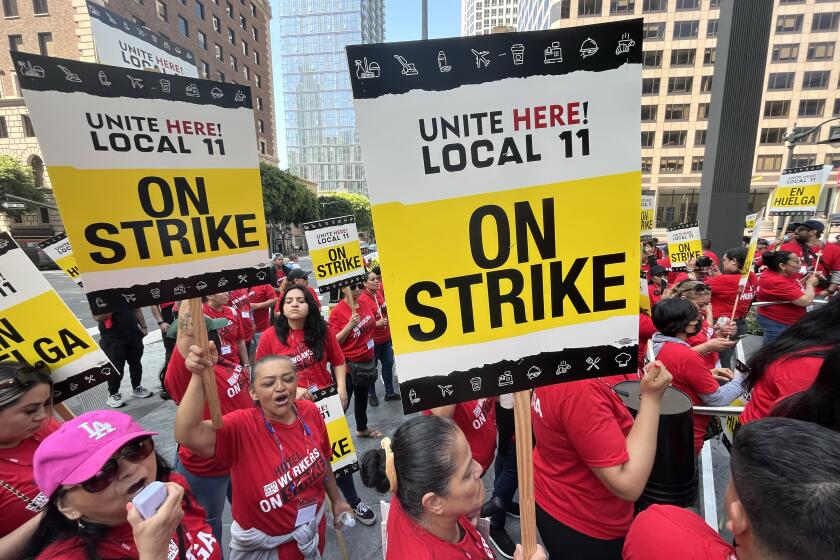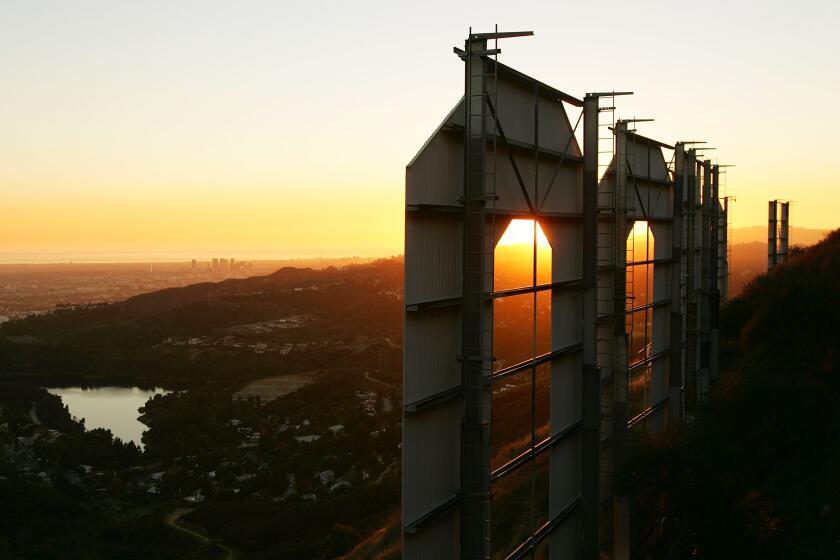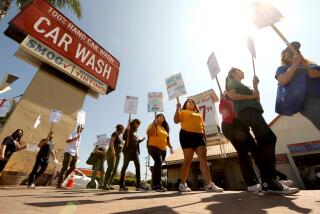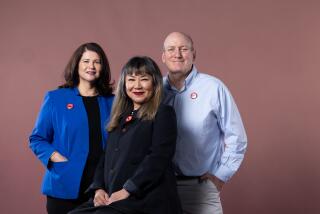Column: This ‘hot labor summer’ is unifying Los Angeles in a way few could have imagined

- Share via
It was 4:30 a.m., but the hit sound of this hot summer echoed up and down the streets near City Hall:
“On strike! Shut it down! L.A. is a union town!”
Members of Service Employees International Union Local 721, which represents more than 7,000 city workers, went on a one-day strike Tuesday to highlight what they claim are stalled contract negotiations and unfair labor practices. It was the first walkout involving city workers in over 40 years.
Winchell’s coffee and donuts sat on a table as about 15 people marched and chanted in a small circle in front of the City Hall steps. Few reached for the energy boost: Their fuel in those early hours was the excitement of joining the stream of labor strikes that has hit Los Angeles over the last 12 months and doesn’t seem to be drying up anytime soon.
In December, UCLA graduate student workers joined a five-week UC-wide strike that was the largest of its kind and led to a historic contract. In March, the Los Angeles Unified School District shut down for three days as teachers walked off their jobs alongside their blue-collar co-workers, who were represented by SEIU Local 99 and trying to negotiate a new contract. The Writers Guild of America is 100 days into its strike, while SAG-AFTRA members stopped showing up to work in July — the first time in 63 years that the two Hollywood unions have gone on strike together.
Thousands of workers at hotels in Los Angeles and Orange counties walked off the job, the latest in a series of labor actions as California workers push for better pay and working conditions.
Unite Here Local 11, which represents hotel and hospitality workers, has staged rolling walkouts across Southern California since the Fourth of July weekend. Kaiser Permanente workers picketed across California last month. UPS just dodged a strike. Starbucks baristas continue to unionize across the Southland.
L.A. has seen consequential labor actions before — the Justice for Janitor campaigns of the 1990s, the supermarket strikes of the early 2000s, the last WGA one — that helped realign city politics. Union members are so ubiquitous ‘round town that the colors of their T-shirts — Unite Here red, SEIU purple, SAG-AFTRA black — are as much a part of the city’s palette as Dodger blue and USC cardinal and gold. .
But what’s happening now feels different. There’s a level of cross-union support across radically different workplaces, along with a knowledge of one another’s respective struggles, that I’ve never seen, or frankly ever thought possible.
In a famously fractured city, it’s a lesson everyone can learn. You don’t have to like the labor movement to see that they’re the canary in the coal mine of L.A.’s economic health. If belonging to a union isn’t enough to guarantee a well-paying job, then what is? And if you can’t care about someone else’s struggles, how good of an Angeleno can you truly be?

United Teachers Los Angeles Vice President Julie Van Winkle and a co-worker received cheers when they joined the SEIU picket line Tuesday morning. “L.A. is at a critical point,” Van Winkle said. “We need a big drastic change, and we can only do that on the streets demanding it together.”
“We’re all united, and we’re not gonna take it anymore,” said SEIU 721 Vice President Simboa Wright, who has been a wastewater collection worker for 20 years. When I asked where he lives, Wright laughed and said, “Inland Empire, because I can’t afford to live here!”
Maria Coreas has worked as a city custodian for 21 years. Living in the city “has gotten worse, because our salaries don’t really go up, but the cost of everything does. The bosses have made promises, and they haven’t complied with them. Well, we need to make them comply.”
Even longtime union leaders — prone to superlatives about solidarity while straining behind closed doors to quash inter-union beefs — are surprised.
Unite Here Local 11 Co-President Ada Briceño asked other unions to support her when she spoke about the struggles of hotel workers at the University of California Board of Regents meeting last month in San Francisco. Representatives of the United Farm Workers and National Union of Healthcare Workers showed up to address the regents. Outside, a loud rally included hundreds of members from the American Federation of State, County and Municipal Employees and the United Auto Workers. Briceño described the moment as “mind-blowing.”
“In my 32 years [of organizing], I have not seen this,” she said. “We have started something for the rest of the nation to follow.”
Los Angeles County Federation of Labor President Yvonne Wheeler led some of the predawn chants in front of City Hall. She credited the joint UTLA-SEIU strike in the spring as what “got us to this moment” of cross-sector unity. This spring, Wheeler called a special Labor Fed meeting to urge unions to not just support one another but learn about one another.
“When they saw the similarity of the issues each of them has to deal with, that’s when they realized people needed to stand together,” Wheeler said. “Your fight is their fight. And an injury to one is an injury to all.”
This so-called “hot labor summer” is especially remarkable because it’s happening during the centennial year of what my fellow Times columnist Patt Morrison has described as L.A.’s Big Bang — when Los Angeles leaders effectively announced to the world that the city had arrived.
The year 2023 marks the centennial of many iconic L.A. landmarks, including the Hollywood sign, Memorial Coliseum, Biltmore Hotel and the Angelus Temple.
1923 is when the Hollywood sign went up, along with the Memorial Coliseum, the Automobile Club of California’s Spanish Colonial Revival headquarters near USC, the Biltmore Hotel and El Cholo Café. The previous year saw the debut of the Rose Bowl and the Hollywood Bowl. All are beloved landmarks today, but they opened as civic temples to the L.A. that boosters wanted to sell, a paradise where the problems of big cities — poverty, diversity, density — were far away.
Part of that sales pitch was also a proudly hostile attitude to workers seeking better wages and the right to organize. 1923 was also the year that famed author Upton Sinclair was arrested in San Pedro for reciting the U.S. Constitution to show his support for striking port workers, whom authorities were arresting by the hundreds. This scorched earth policy reigned for decades in a city whose fathers have long touted its key industries — Hollywood, oil, oranges, housing, aerospace, tech — with the paternalistic view that the bosses and monied few knew better than the rabble about how to develop L.A.
That sort of thinking led to the segregated, stratified megalopolis of today, which seems perpetually on the precipice of collapsing on itself. All these strikes aren’t merely individual efforts but a collective rallying cry: We’re a city of workers — blue collar and white collar, unionized and not, immigrant and native — and no one’s future is secure unless everyone can earn a just wage.
If L.A. can think of itself like this, a more equitable city — one that the titans of a century ago never even considered — is possible.
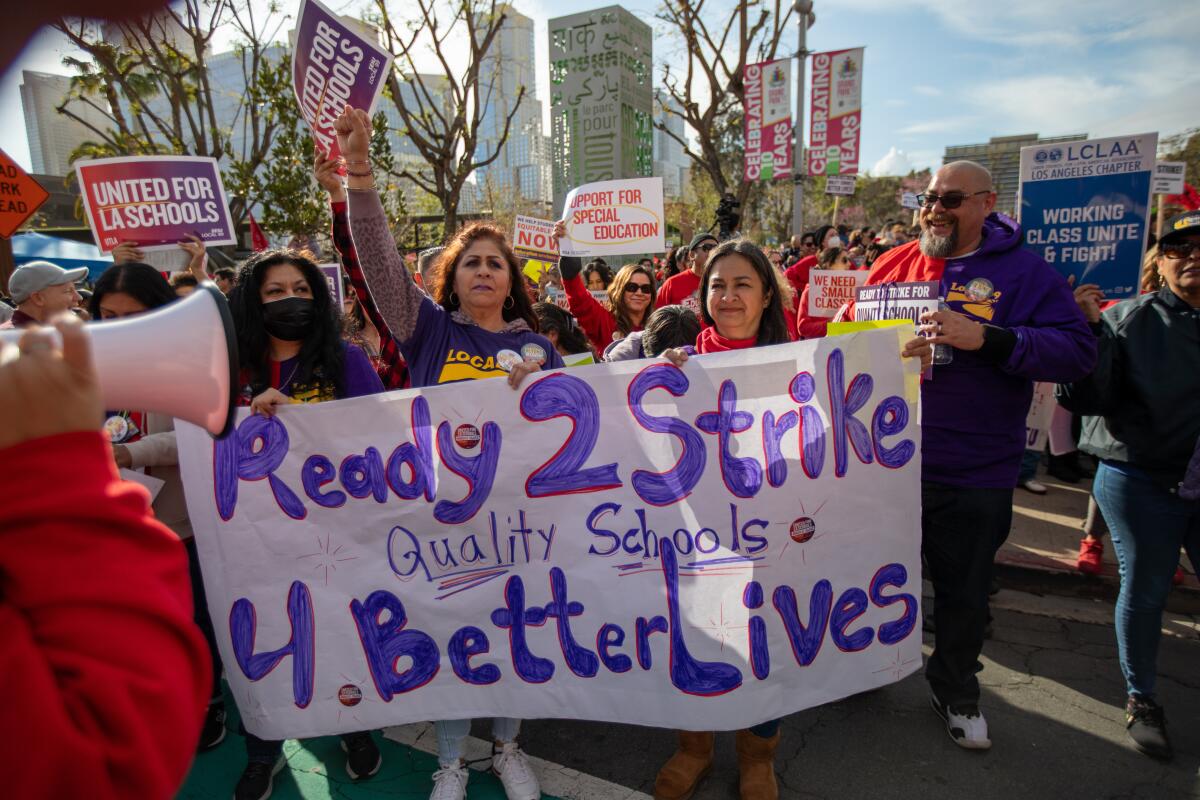
I left the SEIU mini-rally as the sun began to rise. The crowd in front of City Hall now numbered about 100 and was growing by the minute. The next day, the strikers would return to work.
After marching for a good half hour, Assemblymember Isaac Bryan (D-Los Angeles) stood on top of the steps with a picket sign in one hand and a coffee cup in the other.
“L.A. can show the world that you can take care of the people that keep the city running — all parts of it,” he said, softly chanting along with the boisterous crowd. Volunteers were setting up a stage for a lunchtime rally. A flatbed truck displayed 3-foot-tall letters spelling out “Union Strong.”
“It’s not a down moment,” Bryan concluded. “It’s a hope moment.”
More to Read
Sign up for Essential California
The most important California stories and recommendations in your inbox every morning.
You may occasionally receive promotional content from the Los Angeles Times.
